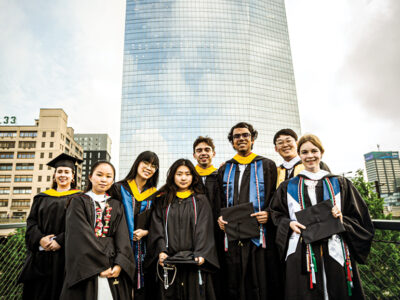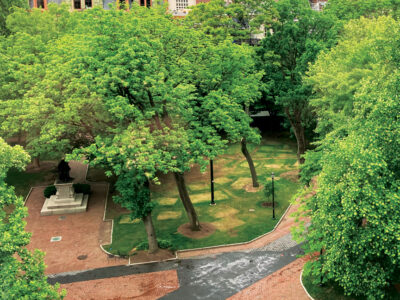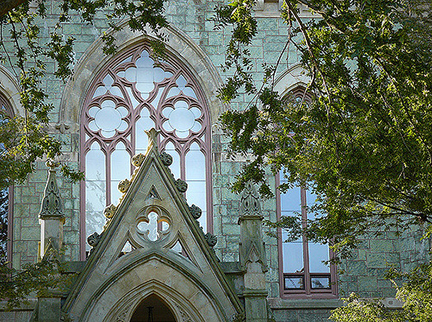A roundtable discussion probed the thorny issue roiling higher education.
Are academic freedom and open expression under siege at American colleges and universities?
That question loomed over the 2023–24 academic year and served as the title of a Penn Faculty Senate Roundtable held at Penn Carey Law School on April 18. Subtitled “Campus Unrest and the Future of the University,” the panel began just three hours after NYPD officers in riot gear arrested more than 100 protesters who had set up an encampment on Columbia University’s campus the day before—and one week before the encampment on College Green began. Those were among more than 60 protests on college campuses resulting in more than 2,900 arrests and detainments this spring, according to the New York Times. But the discussion offered a wider perspective on the intertwined issues of academic freedom and open expression on American campuses.
“I think we are in extraordinarily treacherous times as to what the future of universities are,” said Keith Whittington, a professor of politics at Princeton University. “I wish I could say that this was primarily a post-October 7 phenomenon, but it’s not. This is in fact a challenge that has been going on for several years.”
Whittington, a self-described “right of center” academic, lamented a censorious spirit that he perceives on both ends of the political spectrum. From the left, “student activists, campus administrators, and often university faculty,” he charged, “use tools available to them to suppress and punish” conservative speech, and even moderate and liberal views. Meanwhile, activists on the right have organized to publicize “the most controversial examples of things that are occurring on college campuses” and to mobilize public opinion, donors, and government officials to put pressure on universities.
These campaigns have included state laws curtailing what sorts of scholarship can be presented in classrooms and requiring the inclusion of certain material in service of promoting “intellectual diversity.”
What makes the present situation so alarming, Whittington said, is that the “threats to campus are so wide-ranging” that it has become “particularly hard both to build coalitions in support of universities, and to sustain them against those kinds of pressures.” He expressed trepidation about the future. “I’m not confident how we’re going to come out of it.”
Geoffrey Stone, a law professor at the University of Chicago, offered a thought-provoking account of how open inquiry and academic freedom became established on American campuses to begin with. “If you go back to the 19th century, universities were basically seen as institutions that were there to teach—and to reaffirm—accepted viewpoints. And not to encourage debate, disagreement, or even what we would call scholarship. They were there essentially to educate people in what was the established and accepted wisdom.”
Even in the late 19th century, Stone emphasized, “donors played a very large role in determining what universities would or would not do, what they would teach, what scholarship was permissible. They basically condemned any scholarship or teaching that raised questions about the legitimacy of the power of commercial millionaires. And universities, to a great extent, caved to that.”
Support for unfettered scholarly inquiry was catalyzed by the 1915 formation of the American Association of University Professors, said Risa Lieberwitz, a professor of labor and employment law at Cornell. The AAUP “made demands collectively for academic freedom” at a time when “corporations were becoming very large donors—from the thousands to the millions of dollars,” she noted, “and considering that universities should serve their corporate interests.”
Stone put forward his home institution’s role in galvanizing a broader shift toward open scholarly inquiry and free expression in American higher education. “The University of Chicago was created in 1892,” he said, “with a very different vision to most of the then-preexisting institutions. It was not designed to teach college students. It was about teaching future professors and scholars. And that was at the absolute core” of an enduring institutional identity that he characterized as “exemplary in its commitment to freedom of speech and academic freedom.”
“We were not about teaching people what was already established knowledge, [but rather] about exploring open questions and being critical—critical of one another, critical of past knowledge, and so on,” said Stone, who chaired a 2014 committee on free expression at the University of Chicago whose articulation of “the University’s overarching commitment to free, robust, and uninhibited debate” has since been officially adopted by more than 100 peer institutions. (Penn is not among them.)
Living up to such a commitment is challenging, Stone acknowledged. “But if you make it the core of your identity, and you define yourself that way—and you inform your faculty and students that that’s who we are, and that’s who we want to be—then it is possible to live in that world.”
That may, however, depend on persuading today’s students to embrace, or at least accept, the discomforts that come with it. “I think it’s essential for colleges and universities to be very explicit about their commitment to those values—and I think that it’s also essential to educate students and prospective students about these values,” Stone concluded. “Students in higher education today do not have the same willingness to be open-minded as they have in much of the past. They’ve been brought up differently, and they’re more willing to say, You’ve hurt my feelings, and I can’t listen to this, and I’ve got to shut it down. And that’s a real challenge. I think part of what we need to do as a nation is to recognize that in the educational process—not just in universities, but well before that—it’s essential to educate students to understand the importance of having an open mind and listening to views you disagree with and thinking about things.”
Stone further argued that institutional neutrality serves as a central pillar of academic freedom and open expression. He touted the University of Chicago’s 1967 Kalven Report, which has inspired much discussion in academia of late, as a blueprint with enduring relevance. Issued amid widespread calls for American universities to condemn the US war on Vietnam, the Kalven Report “essentially said the university does not take positions on issues of policy that are not directly related to the functioning of the institution itself,” Stone summarized. “The core principle was that we [as a university] do not take positions—our faculty take positions, our students take positions.”
“That is, I think, another fundamental value that universities need to embrace,” Stone said. “They have to understand that it is not their role to take public positions on matters that are controversial. However confident the board of trustees may be, or the president may be, or even the majority of the faculty may be that a particular position is right or wrong, the fact remains that we have learned over time that positions that we believe to be crazy, or wrongheaded, may well turn out to be right. Think of an issue like gay rights, for example. It would have been unimaginable for faculty to take positions in favor of gay rights 75 years ago. But because we were open to that—because we didn’t silence that—we were able to hear those arguments, listen to them, and build upon it.”
“That’s why we exist: to enable faculty and students to explore ideas, to challenge one another, to learn from one another,” Stone said, “and not to have the institution interfere with that at all.”
Yet institutional neutrality may be easier proclaimed than carried out.
“Its appeal is very apparent,” Lieberwitz said. “It’s connected to the academic mission of creating a wide space for ideas. And it seems to have a very practical effect, too, in that it lifts a certain amount of pressure off administrations and departments that don’t have to comment on everything that happens all the time and open themselves up to all the political winds.”
But “neutrality is simply impossible in some cases,” she added. “For instance, if there’s pressure to divest from fossil fuels”—as has happened at Penn and elsewhere—“either a university does it or doesn’t do it. Either way, it’s a political position.” The demands for divestment from Israel or from arms manufacturers common among pro-Palestinian encampments would seem to present similar challenges to the concept.
No panelist brought a silver bullet to the discussion. But each, in their own way, extolled the virtues of consistency. Though it was not quite the final word, Whittington offered a parting thought that would prove resonant in the month ahead.
“Part of what we want to try to protect is freedom of speech quite broadly in the public sphere—including things students want to engage in and including faculty who are not an expert on a particular topic but who have personal opinions they want to express publicly,” he said. “On that, I am a bit of an extremist and really think there’s really nothing that can’t be said and thought about within that realm and context.”
Whittington noted that he sits on the board of directors of the Foundation for Individual Rights and Expression, which focuses primarily on protecting student speech rights. “It’s been a challenging area for a long time, in some cases because policies that universities have are not very good,” he remarked. “But in many, many, many cases, it’s because university administrators don’t live up to the policies they actually have in place. They violate those policies a lot. They very frequently enforce them in unequal ways. And we’re seeing a version of that right now.
“From an advocacy perspective,” he continued, “part of my concern is to insist that universities have policies that are as good as possible from a protecting-free-speech perspective, and that are compatible with the operation of the university—and that they enforce them in an evenhanded and politically neutral fashion across the range of disputes that occur.
“Where I think some of this actually is a little less clear-cut,” he added, relates to “disciplining students, for example, for nonviolent demonstrations in protest. And here, I would just emphasize that I think the key distinction is not violent-versus-nonviolent, but does it violate neutral ‘time, place and manner’ regulations? We see lots of instances of protest activity on campuses that are in fact nonviolent but nonetheless in violation of university policy. And what we want is universities to be neutrally enforcing the policies. Sometimes then students just have to take their lumps if they’re engaged in that—but they ought to be aware that they’re engaged in a form of civil disobedience, and that there are consequences to engaging in civil disobedience.” —TP




